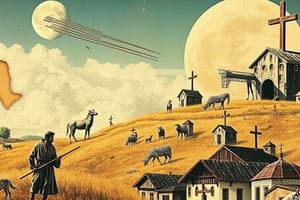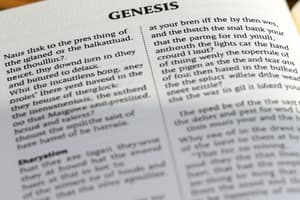Podcast
Questions and Answers
What is the outcome for the woman who tasted the fruit from the garden?
What is the outcome for the woman who tasted the fruit from the garden?
- She ascended to heaven
- She became the ruler of the garden
- She was banished from the garden (correct)
- She was rewarded with eternal life
Skywoman is portrayed as a figure who created a garden for the well-being of all.
Skywoman is portrayed as a figure who created a garden for the well-being of all.
True (A)
What two contrasting stories are presented in the content?
What two contrasting stories are presented in the content?
Creation stories of Skywoman and the woman who was banished from the garden.
The exile woman was instructed to subdue the __________ into which she was cast.
The exile woman was instructed to subdue the __________ into which she was cast.
Match the following concepts with their descriptions:
Match the following concepts with their descriptions:
What is a key feature of Genesis 1 as highlighted in the content?
What is a key feature of Genesis 1 as highlighted in the content?
Cosmologies do not play a significant role in shaping our identity and orientation to the world.
Cosmologies do not play a significant role in shaping our identity and orientation to the world.
What event marked the beginning of the Silver Age?
What event marked the beginning of the Silver Age?
During the Silver Age, the land was considered a common good that all could share.
During the Silver Age, the land was considered a common good that all could share.
What crops did men begin to plant in the Silver Age?
What crops did men begin to plant in the Silver Age?
The Silver Age is characterized by the rise of _____ and sacrilege.
The Silver Age is characterized by the rise of _____ and sacrilege.
Match the following characteristics with their descriptions during the Silver Age:
Match the following characteristics with their descriptions during the Silver Age:
What was Adam formed from?
What was Adam formed from?
God allowed Adam to eat from the tree of the knowledge of good and evil.
God allowed Adam to eat from the tree of the knowledge of good and evil.
What did God create to be a helpmate for Adam?
What did God create to be a helpmate for Adam?
Adam named his wife __________, meaning 'mother of all living'.
Adam named his wife __________, meaning 'mother of all living'.
What consequence was given to the serpent after the fall?
What consequence was given to the serpent after the fall?
The woman took the fruit from the tree after seeing it was good for food.
The woman took the fruit from the tree after seeing it was good for food.
What did Adam do with the animals created by God?
What did Adam do with the animals created by God?
Why did God create a woman for Adam?
Why did God create a woman for Adam?
Match the following characters or elements from Genesis 2 with their descriptions:
Match the following characters or elements from Genesis 2 with their descriptions:
What is the consequence given to Eve regarding childbirth?
What is the consequence given to Eve regarding childbirth?
Adam was created in the Divine Image.
Adam was created in the Divine Image.
What is the primary curse given to Adam related to sustenance?
What is the primary curse given to Adam related to sustenance?
Eve's status is described as DERIVATIVE, SUBORDINATE, and ________.
Eve's status is described as DERIVATIVE, SUBORDINATE, and ________.
Match the consequences to their corresponding individuals:
Match the consequences to their corresponding individuals:
What describes Eve's relationship to Adam?
What describes Eve's relationship to Adam?
Adam and Eve's original state was one of labor and sorrow.
Adam and Eve's original state was one of labor and sorrow.
What knowledge did Adam gain that was likened to God-like knowledge?
What knowledge did Adam gain that was likened to God-like knowledge?
The dualistic logic of Genesis 1 manifests Adam's superiority through ___________.
The dualistic logic of Genesis 1 manifests Adam's superiority through ___________.
Which of these activities is not mentioned as part of Adam's curse?
Which of these activities is not mentioned as part of Adam's curse?
What is the primary notion in the land where Judeo-Christian people find themselves?
What is the primary notion in the land where Judeo-Christian people find themselves?
The creation described in Ovid's 'The Metamorphoses' emphasizes a monotheistic belief system.
The creation described in Ovid's 'The Metamorphoses' emphasizes a monotheistic belief system.
What aspect of humanity is emphasized in the creation process according to the text?
What aspect of humanity is emphasized in the creation process according to the text?
Ovid compares creation to the work of __________ and categorization, bringing order to chaos.
Ovid compares creation to the work of __________ and categorization, bringing order to chaos.
What does the creation of man signify?
What does the creation of man signify?
The text implies that all animals are designed to stand upright and look towards the stars.
The text implies that all animals are designed to stand upright and look towards the stars.
What does the process of procreation and succession in nature symbolize in the text?
What does the process of procreation and succession in nature symbolize in the text?
The transformation of the earth, where it became more ___________, showcases the power of creation.
The transformation of the earth, where it became more ___________, showcases the power of creation.
What separates sky and earth according to the text?
What separates sky and earth according to the text?
Flashcards
Golden Age
Golden Age
A mythical time of abundance and paradise, often depicted as a perfect state of existence before the fall of humanity.
Garden of Eden
Garden of Eden
A biblical story depicting a paradise garden where Adam and Eve lived before disobeying God and being exiled.
Turtle Island
Turtle Island
A concept that describes a mythical or idealized past, often associated with Native American traditions, representing a harmonious relationship with nature.
Pastoral Poetry
Pastoral Poetry
Signup and view all the flashcards
Creation by Division/Separation
Creation by Division/Separation
Signup and view all the flashcards
Creation of 'Man' in God's Image
Creation of 'Man' in God's Image
Signup and view all the flashcards
Generous Embrace of the Living World
Generous Embrace of the Living World
Signup and view all the flashcards
Adam's Creation
Adam's Creation
Signup and view all the flashcards
Forbidden Fruit
Forbidden Fruit
Signup and view all the flashcards
Creation of Eve
Creation of Eve
Signup and view all the flashcards
Serpent's Deception
Serpent's Deception
Signup and view all the flashcards
Fall from Grace
Fall from Grace
Signup and view all the flashcards
Serpent's Curse
Serpent's Curse
Signup and view all the flashcards
Curse on Adam and Eve
Curse on Adam and Eve
Signup and view all the flashcards
Eve's Name
Eve's Name
Signup and view all the flashcards
Clothing and Shame
Clothing and Shame
Signup and view all the flashcards
Adam's Earthiness
Adam's Earthiness
Signup and view all the flashcards
Labor and Sorrow
Labor and Sorrow
Signup and view all the flashcards
Eve's Derivation
Eve's Derivation
Signup and view all the flashcards
Eve's Temptation
Eve's Temptation
Signup and view all the flashcards
Eve's Curse
Eve's Curse
Signup and view all the flashcards
Adam's Name-Giving Power
Adam's Name-Giving Power
Signup and view all the flashcards
Expulsion from Eden
Expulsion from Eden
Signup and view all the flashcards
Knowledge of Good and Evil
Knowledge of Good and Evil
Signup and view all the flashcards
The Tree of Life
The Tree of Life
Signup and view all the flashcards
Till the Ground
Till the Ground
Signup and view all the flashcards
Silver Age
Silver Age
Signup and view all the flashcards
How did the world change in the Silver Age?
How did the world change in the Silver Age?
Signup and view all the flashcards
Property and control in the Silver Age.
Property and control in the Silver Age.
Signup and view all the flashcards
What is Ovid's imagery of sailboats?
What is Ovid's imagery of sailboats?
Signup and view all the flashcards
What does Ovid say about the end of the Silver Age?
What does Ovid say about the end of the Silver Age?
Signup and view all the flashcards
Exile as Human Condition
Exile as Human Condition
Signup and view all the flashcards
Ovid's Four Ages
Ovid's Four Ages
Signup and view all the flashcards
Prometheus and the Creation of Humanity
Prometheus and the Creation of Humanity
Signup and view all the flashcards
Creation by Division and Categorization
Creation by Division and Categorization
Signup and view all the flashcards
Creation through Metamorphosis
Creation through Metamorphosis
Signup and view all the flashcards
Human Dominion over Nature
Human Dominion over Nature
Signup and view all the flashcards
Human Exceptionalism
Human Exceptionalism
Signup and view all the flashcards
Humans Created in God's Image
Humans Created in God's Image
Signup and view all the flashcards
Polytheism and Godly Power
Polytheism and Godly Power
Signup and view all the flashcards
Monotheism vs. Polytheism
Monotheism vs. Polytheism
Signup and view all the flashcards
Study Notes
Utopianism Before Utopia
- The concept of a Golden Age, the Garden of Eden, Turtle Island, and Pastoral Poetry are precursors to utopianism.
- Myths of origin, exile, retreat, and return are recurring themes in these earlier expressions of utopian ideals.
Creation Stories and Cosmologies
- Two contrasting perspectives on the world's creation and the human relationship with nature are presented.
- One perspective involves a harmonious relationship with nature, symbolized by Skywoman's garden.
- The alternative perspective focuses on banishment, hardship, and the need to subdue nature. Both views are embedded in cosmologies and Creation stories.
- These stories shape a culture's identity and understanding of the world.
Genesis 1: Key Features
- Creation by division (light/darkness, day/night).
- Creation through a performative speech act ("Let there be light").
- A dualism exists between spirit and matter, with spirit (God) as superior. The earth was initially formless and void.
- God created humans in his image (male and female) and granted them dominion over the earth.
Genesis 2: Summary
- Adam, formed from dust, was placed in the Garden of Eden.
- Adam is allowed to freely consume from every tree except the tree of knowledge.
- God created animals and birds and allowed Adam to name them.
- A woman was created as a "help meet" for Adam from his rib.
- The serpent tempted the woman and Adam to eat from the forbidden tree.
- Humans are now aware of their nakedness and face expulsion from the garden.
Genesis 2: The Curse/ The Fall
- God curses the serpent, making it the enemy of womankind.
- God curses the woman with pain in childbirth and subordination to her husband.
- God curses Adam, making work on the earth difficult.
- Adam and Eve are expelled from the Garden of Eden.
Genesis 2: Key Themes and Differences
- The earthiness of Adam (formed from dust) is emphasized.
- The fleshiness of Eve's character and the theme of her relation to Adam are explored.
- The concept of the succession of ages from the Golden to Iron Ages are explained.
- The role of technology, agriculture, settlements, and knowledge is highlighted.
Ovid, the Four Ages
- Ovid's Four Ages (Gold, Silver, Bronze, Iron) provide an alternative timeline compared to Genesis's description.
- Similarities include the theme of creation, order, and the nature of human dominion. The ages emphasize the declining quality of the human experience.
- Differences include polytheism with human-like deities in Ovid and the focus on human behavior in determining the ages in Ovid.
Ovid: The Golden Age
- The Golden Age is a period of peace and prosperity.
- The elements of nature spontaneously produce food.
- Humans live simply without laws and punishments.
- Features include an absence of formal structure.
Ovid: “Declension Narrative”
- The Silver Age is marked by harsh weather, settlements (houses), and agriculture.
- The Bronze Age is marked by conflict, wars, and navigation.
- The Iron Age is characterized by greed, navigation, greed, and the search for resources from the earth.
- A decline in the human experience is emphasized as the ages progress.
Key Differences from Genesis
- Polytheism, personal psychology.
- Procreation (succession/metamorphosis) differs from "after its kind."
- Creation is a succession of events, not a singular speech act.
- Causation/culpability is less emphasized, rather the change is linked to the ages.
- Technological development is seen as part of the decline.
The Passionate Shepherd to His Love
- A poem expressing ideals of pastoral life, love, and nature.
- The depiction of a romantic ideal emphasizes beauty, nature, and the rural life.
Polarities of Pastoral
- Polarities of pastoral poetry include rural/urban, simplicity/sophistication, leisure/business, folk culture/elite culture, orality/literacy, authenticity/artifice, and spontaneity/technique.
- The poem highlights the theme of nature vs. culture.
Kimmerer, "Skywoman Falling"
- Skywoman, falling from the sky world, lands on earth.
- The event is characterized by light, darkness, and the presence of animals.
- The landing signifies the beginning of human life and a connection to nature.
Kimmerer, "Skywoman Falling": Basic Similarities
- Emphasis on falling from the realm of the transcendent to establish earthly existence.
- Emphasis on the passage from emptiness (darkness or water) and a new life on earth.
- Connection to the elements of nature by the acts of animals, and the creation of the “Tree of Life”
Relation to the Animals
- The author emphasizes the importance of understanding human relations with animals and the broader natural world.
- Respect and gratitude to the natural world is seen as critical to survival.
- Mutual aid, cooperation, and reciprocity between humans and animals were critical aspects of life. The human role is to learn from other species.
Studying That Suits You
Use AI to generate personalized quizzes and flashcards to suit your learning preferences.




